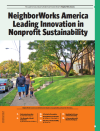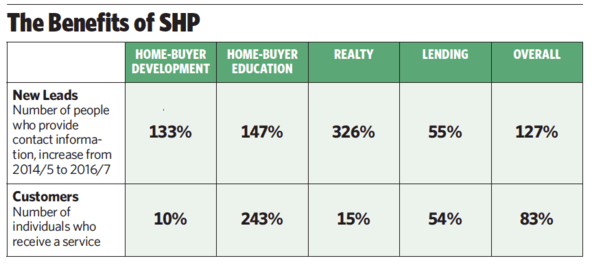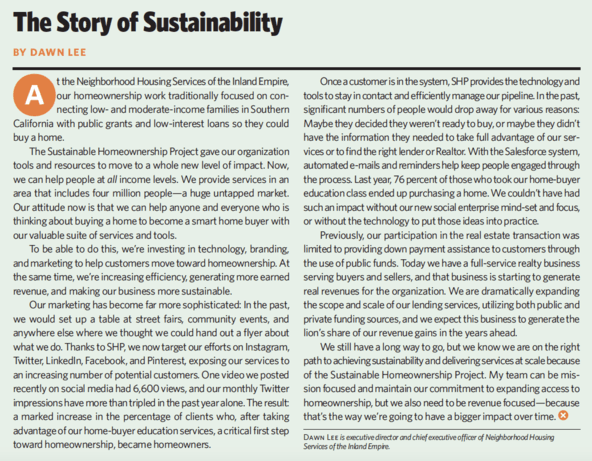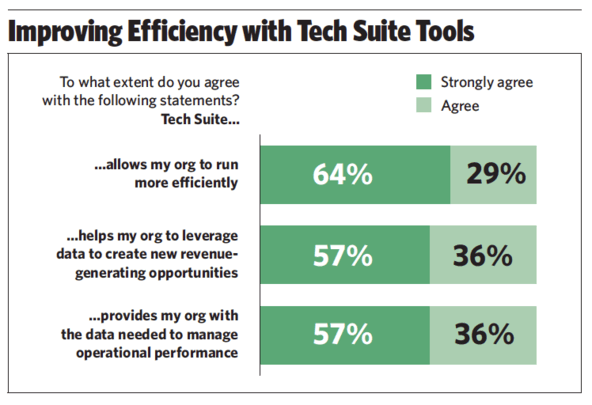The NeighborWorks HomeOwnership Center in Utica, N.Y., tried something radical to attract a younger demographic. “Let’s get you out of mom’s basement,” read the tagline from a recent advertising campaign. Aimed at millennials, the radio and TV ads use humor to reach the younger audience and undercut the widespread belief among this group that homeownership is out of reach for them.
NeighborWorks America Leading Innovation in Nonprofit Sustainability

This special supplement examines how NeighborWorks America, a 40-year-old congressionally chartered nonprofit, has partnered with its member organizations to leverage social enterprise, innovate its business practices, and boost its impact in helping people become homeowners.
“It’s not that members of this age group don’t want to buy a home,” CEO Danielle Smith says. “They’re told again and again that they need to pay off their student loans and focus on their careers before they even think about homeownership.”
The goal of the ad campaign, which includes extensive social media, is to get more millennials to take advantage of the center’s services, such as home-buyer education, down-payment assistance, and financial coaching.
The “mom’s basement” campaign is just one example of how organizations in the NeighborWorks network are changing how they reach out to and interact with the people they serve. They actively target specific populations with sophisticated marketing campaigns. They use technology to boost efficiency and streamline the process of signing up for services and buying a home. They’re adding new, cash-generating business lines such as realty and lending services, and actively cross-selling these offerings to encourage people to take advantage of as many services as possible.
These changes are the result of NeighborWorks America’s efforts to foster social enterprise across its network.
Introducing Sustainability
In order to introduce the ideas and practices of social enterprise to its nationwide network of nonprofits, NeighborWorks America in collaboration with a small cohort of network nonprofits created the Sustainable Homeownership Project (SHP), a system of tools and resources to help nonprofits transform their culture and implement a new business model.
We have seen how financial coaching puts our customers in the best position to own a home. It is generating more revenue for us as well.
Many nonprofits were created to provide services that they and their funders consider to be essential. As a result, they may tend to wait for people to come to them. It’s a philosophy of “If you build it, they will come.” Those people who do come knocking often receive one-size-fits-all support: services designed by the organization to meet its (and its funders’) definition of client and community needs. If the demand doesn’t materialize or if the nonprofit isn’t getting the anticipated results, the organization’s funders may lose interest and move on to something else—leaving both the nonprofit and its community to fend for themselves.
The social enterprise calculus behind SHP turns this approach on its head. Participating NeighborWorks organizations focus on how to find customers and how to personalize service, providing what each individual customer needs. Various business lines generate revenue for the organization, providing greater independence from grants and philanthropy and new flexibility to design products and services that serve their customers. To the extent that customers see and understand the value in what the organization offers, they will pay for those services. The HomeOwnership Center and other participating organizations remain focused on their mission of expanding homeownership, but they also expand revenues so they can have an impact in their communities that is sustained for years to come.
SHP “changed the mind-set of this organization, so we are thinking more like a business all the time,” says Smith, who left a career in banking to work at Utica’s HomeOwnership Center. “We’ve completely dropped the mentality that we have to wait for people to come to us.” Like their peers at other NeighborWorks organizations across the country, the center’s staff no longer talk about “clients”; now they work with “customers.”
NeighborWorks organizations participating in SHP see marked increases in the number of people using their services. Those organizations that took part in both Phase 2 and Phase 3 of the project more than doubled their customer leads—that is, customer inquiries about services. In addition, they more than tripled the number of people enrolled in home-buyer education classes. (See “The Benefits of SHP.”) These classes, incidentally, are often the first opportunity for NeighborWorks organizations to charge a nominal fee for their services and generate revenue.
Additionally, participating organizations see notable increases in customer accounts, increased digital engagement, and an uptick in the number of customers using mobile devices to access products and services and engage with the nonprofit. (See “Keeping Customers Engaged: SHP Results.”) Equally important, the program brings notable increases in revenues and operational efficiency, as evidenced by a rise in the percentage of operating expenses covered by earned income. (See “Realty and Lending Provide New Revenue.”) In fact, this “sustainability ratio” measure has increased a remarkable 200 percent for three SHP organizations.
Representatives of the participating NeighborWorks organizations say SHP’s social enterprise framework helped them become more customer-centric and more focused on sales and revenue in three ways: by strengthening their marketing and branding efforts; by facilitating the adoption of new technologies that streamline engagement, management, and retention of customers; and by supporting them to pursue new business strategies for increasing sales and expanding services.
Marketing: Meeting Customers Where They Are
Gabriella Marchesani joined the HomeOwnership Center staff in 2014 after graduating from a local college with a degree in public relations. Her position as marketing coordinator at the center is a perfect fit, she says, because the center’s customer base has been skewing younger in recent years. “We were starting to see that the largest group of people coming through our system were in the 24-to-35 [age] range,” Marchesani says. She set out to help the center market its services to her peers in the millennial generation.
Using tools and strategies from SHP, Marchesani and her colleagues launched a wide-ranging marketing and branding effort targeting young adults. Radio and TV advertising adopted an attention-grabbing tone, with the “mom’s basement” ads leading the way. The HomeOwnership Center also made its first foray into targeted online marketing, such as Google ads that appear in response to searches for houses or home-buying assistance.
The center also became the first NeighborWorks organization to offer “bundled” services to prospective home buyers that encourage them to make use of valuable resources. Customers who sign up for both home-buyer education classes and financial coaching save $25. Smith says this simple change has more than doubled the number of people enrolled in financial coaching, a critical service that can be a harder sell for prospective home buyers who are eager to move quickly in buying a home. “Time and again, we have seen how financial coaching puts our customers in the best position to own a home,” says Smith. “Now we have more people taking advantage of this service, and it’s generating more revenue for us as well.”
The HomeOwnership Center also hired an outreach specialist who meets with real estate agents and local businesses to spread the word about its services. “Sitting in the office is not the way to build relationships in the community,” says Smith. “We needed that person who is out hunting for leads and telling people what we do and what we offer.”

The results are evident: a 40 percent jump in enrollment in home-buyer education classes, along with a 30 percent increase in the number of customers who successfully purchased homes with the center’s help. SHP technology enables Marchesani and her colleagues to track how customers find their way to the center, and this data shows that 68 percent of customers are learning about the center through its advertising and marketing activities.

Millennials, Marchesani’s original market, are responding “in a big way,” she says. “No one teaches you at age 25 how to prepare for homeownership,” she adds. “Even if they attend a home-buyer education class and find out they aren’t ready yet, they are getting a lot of good information about managing debt and building assets and starting down the road to financial stability and success.”
Technology: New Ways to Find and Keep Customers
The nonprofit homeownership industry has lagged other industries in terms of using technology to engage virtually with customers. For the first time ever, because of a tech-based tool (SHP Tech Suite) by the SHP cohort and resourced by NeighborWorks America, customers can create an account with the NeighborWorks organization. Customers use their accounts to schedule and pay for appointments and classes, upload and download documents, and monitor the status of their tasks as they progress toward homeownership.
Tech Suite lets neighbors start the home-buying process virtually, whether they are in the computer lab in our lobby or sitting at home in their pajamas.
The NeighborWorks Rochester website, like similar technologies adopted by other organizations across the NeighborWorks network, is a direct result of the Sustainable Homeownership Project. As part of SHP, representatives of NeighborWorks Rochester and other organizations designed the Tech Suite to facilitate the process of customer acquisition and retention that could be used by all members of the network. Based on the Salesforce customer relationship management (CRM) system, the Tech Suite provides organizations with a platform that can be fine-tuned to help customers navigate the home-buying process from a smartphone, computer, or tablet.
“It’s really caused a revolution in how we work,” says Greg Stefl, operations manager with NeighborWorks Rochester. The system is used across the organization, in order to streamline and simplify the process for customers, or “neighbors,” as NeighborWorks Rochester refers to them. “This lets neighbors start the home-buying process virtually, whether they are in the computer lab in our lobby or sitting at home in their pajamas,” Stefl says.
The system also helps the staff at NeighborWorks Rochester to shepherd customers through the process more efficiently. It includes both a platform for NeighborWorks staff use and a program for customers. Shoppers can sign up for home-buyer classes and financial coaching, schedule appointments and phone calls, upload documents and information, and track their progress toward buying a home. On the organizational side, the CRM system allows staff to log all contacts with a customer in a secure repository, enabling them to plan and customize support.
“With the CRM, we can see in one glance our neighbors’ full stories, including how they have interacted with us and the services they have taken advantage of to date,” Stefl says. “That helps us identify other opportunities to serve each neighbor.” It also makes it easier for staff to connect customers to other personnel.

Before the Salesforce system was implemented, the staff at NeighborWorks Rochester and many other organizations in the network used various software systems designed specifically for homeownership counseling. Or sometimes, they simply used a lot of paper. “Relying on spreadsheets, notepads, and paper was getting old,” Stefl says. “It was also very inefficient. But now we have this centralized system where you have access to everything at the click of a button.”
The transition to the new system was not without headaches, Stefl admits. They had to become familiar with the new technology and get used to a new way of managing the clients’ data. But now that all staff are trained, NeighborWorks Rochester is a significantly more efficient organization. In 2016, the nonprofit was faced with a large influx of new customers when a local bank redirected its referrals from another community organization to NeighborWorks. While adding the new customers and simultaneously focusing on increasing efficiencies, Stefl and his team were able to reduce NeighborWorks Rochester’s “cost per customer” from a pre-SHP baseline of $5,877 to just $18 in 2017. In addition, the nonprofit’s “service velocity”—the average number of days it takes to serve a homeownership customer—dropped by nearly two-thirds over the same period, from 244 days to merely 80 days.

Other organizations are equally enthusiastic about the Salesforce system. Among the network organizations that participated in Phase 2 and Phase 3 of SHP, 85 percent either strongly agreed or agreed that the Tech Suite helped them “improve and personalize the customer experience.” And 93 percent strongly agreed or agreed that it helped them “serve each customer faster.” (See “Improving Efficiency with Tech Suite Tools” below.) When convened in a focus group about SHP, organizations estimated that they now can serve 65 new customers for every single customer they served previously—a massive increase in efficiency.
Expanding Services: Giving Customers More Value
NeighborWorks organizations are also expanding the products they offer, in order to bring in additional revenues and build more sustainable businesses.
Karen Turner joined the staff of Virginia-based Community Housing Partners (CHP), a community development organization, after almost 30 years in the banking industry. When she came on board in 2014, CHP’s CEO and director of homeownership were deeply involved in SHP. From the start, the project’s focus on increasing customer engagement, converting leads into paying customers, and expanding the organization’s product offerings made sense to Turner.
“Coming from a banking background, I had worked with organizations where the focus was always on getting people to use the full complement of the services you offer,” Turner says. “That’s where you really get a win-win for both the organization and the customer.”
CHP is a 400-employee organization with a real estate development portfolio spanning more than half a dozen states. It also operates two homeownership centers—one-stop locations for customers who want to buy, maintain, or retain their home—in Christiansburg, Va., and Inverness, Fla. However, as an organization that traditionally focused on developing and owning rental properties, CHP tended to approach its homeownership development work in an “opportunistic” way, Turner says. “As single-family development projects came along, we would find people to live in those homes and then provide education, counseling, and realty services as part of the development work.”

Thanks to the Sustainable Homeownership Project, CHP was able to develop its homeownership business, building a pipeline of customers of all incomes who could take advantage of the full range of CHP services. “We shifted from a development organization that provided counseling and education services to a full-service homeownership provider,” Turner says.
As part of this shift, CHP expanded the scope of its realty operations in Virginia and Florida. Across the two offices, transactions grew by 40 percent between 2014 and 2016. Over a four-year period between 2013 and 2017, CHP also doubled the number of customers using its home-buyer development services and increased the number of “homeowners created”—the number of people who move into homes—by more than 500 percent. Consequently, the organization’s earned revenue more than doubled, and its sustainability ratio (the portion of operating expenses covered by earned income) increased from 51 percent to 91 percent.
“We could not have done this without SHP,” says CHP client service manager Alicia McCoy. Participating in the project “totally transformed the way we thought of our work and our hopes and aspirations for what we could be,” she adds. “We’ve broken the mold and we’re better because of it.” Staff maintain the organization’s mission, while focusing on finding and serving more customers and increasing efficiency, bringing in more earned revenue, and creating a more sustainable organization.
It’s a story that is playing out in organizations and communities across the country, thanks to the social enterprise ethos embraced by NeighborWorks America and its national network.
“For the organizations we’re working with, the social enterprise approach and mind-set have supported them to have bigger impact,” says Marietta Rodriguez, the acting senior vice president of national initiatives at NeighborWorks America who launched SHP. “Once that starts happening, it’s hard to turn back the tide. These organizations now have the management chops, the resilience, and the organizational strength to sustain this work even if they lose their CEO or face other challenges. From top to bottom, they see social enterprise as a means to an end, which is a scaled, well-functioning nonprofit organization that can deliver its mission more effectively.”
Support SSIR’s coverage of cross-sector solutions to global challenges.
Help us further the reach of innovative ideas. Donate today.
Read more stories by William H. Woodwell, Jr..

